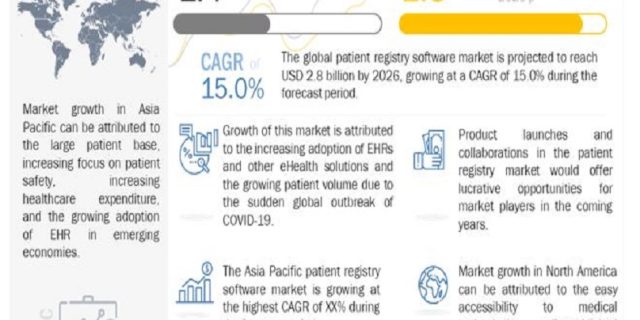
The use of cloud-based patient registry solutions helps deliver insights from a multi-terabyte database anywhere, anytime, and on any platform, with ease. In addition, these solutions do not require any upfront capital investment for hardware and provide faster data transfer between organizations. Considering these advantages, the preference for cloud-based patient registry solutions is expected to increase among end users during the forecast period.
The global Patient registry software market is projected to reach USD 2.8 billion by 2026 from USD 1.4 billion in 2021, at a CAGR of 15.0% during the forecast period.
Download PDF Brochure: https://www.marketsandmarkets.com/pdfdownloadNew.asp?id=144694594
Key Market Dynamics
1.DRIVERS
1.1 Government initiatives to build patient registries
1.2 Rising pressure to improve quality of care and reduce healthcare costs
1.3 Rising adoption of EHRs and other eHealth solutions
1.4 Growing patient volume due to global outbreak of COVID-19
1.5 Growing use of patient registry data for post-marketing surveillance
2. RESTRAINTS
2.1 Privacy- and data security-related concerns
2.2 Shortage of trained and skilled resources
3. OPPORTUNITIES
3.1 Rising number of accountable care organizations
3.2 Emergence of cloud-based patient registry solutions
3.3 High adoption rate of subscription model
4. CHALLENGES
4.1 Lack of interoperability and integration
4.2 Reluctance to adopt advanced solutions
4.3 Lack of awareness.
Market Segmentation:
On the basis of type of registry, the disease registries segment accounted for the largest share of the patient registry software market in 2020. The large share of this segment can be attributed to the increase in the aging population, rising prevalence of chronic and rare & new diseases, growing awareness on the role of registries in health management, and the adoption of EHRs across the globe.
Based on end user, the hospitals & medical practices segment is expected to register the highest CAGR during the forecast period. Factors responsible for the growth of this segment are growing prevalence of research, QM and improvement, facility planning and marketing, and monitoring patient outcomes.
Regional Analysis:
Growth of the patient registry software market in the Asia Pacific region is mainly driven by the increasing incidence of chronic diseases, rising awareness about the benefits of EHRs, improvements in healthcare systems, the development of medical tourism in Asian countries, and high demand for EHRs in Asian countries. The adoption of innovative technologies is increasing in Asia Pacific. In this region, disease registries are a prime focus area, while medical devices and other product registries are comparatively underdeveloped. The region shows a very high demand for EHRs due to its rising geriatric population and prevalence of chronic conditions.
Inquiry Before Buying : https://www.marketsandmarkets.com/Enquiry_Before_BuyingNew.asp?id=144694594
Recent Developments of Patient Registry Software Industry
- In March 2021, ESO Solutions (US) entered into a partnership with Virginia EMS Systems (US) to deliver a statewide EMS data repository and statewide trauma registry for the collection and analysis of data to reveal key insights and trends.
- In December 2020, ImageTrend, Inc. (US) announced the latest National Trauma Data Bank (NTDB) Data Dictionary will be available in Patient Registry on January 1, 2021.
- In November 2020, ArborMetrix, Inc. (US) entered into a partnership with the American Academy of Pediatrics to develop and grow a clinical registry to advance all children’s health, well-being, and development.
Top Key Players:
Some of the prominent players in this patient registry software market are IBM Corporation (US), IQVIA Holdings (US), OpenText Corporation (Canada), Optum (US), Premier, Inc. (US), ArborMetrix, Inc. (US), FIGmd (US), McKesson Corporation (US), Syneos Health (US), Dacima Software, Inc. (Canada), ifa Systems AG (Germany), Medstreaming- M2S (US), ImageTrend, Inc. (US), Evado Clinical (Australia), WIRB Copernicus Group (US), Global Vision Technologies, Inc. (India), Conduent, Inc. (US), Elekta AB (Sweden), Cedaron (US), LUMEDX (US), Armus Corp (US), Phamax AG (Switzerland), and Versaform Systems Corp (US), ESO Solutions (US) and Ordinal Data, Inc. (US).
In conclusion, the emergence of cloud-based patient registry solutions has revolutionized how healthcare organizations manage patient data and conduct medical research. The benefits of scalability, cost-efficiency, accessibility, security, and data analytics make cloud-based solutions an attractive option for organizations aiming to streamline their patient registry operations and accelerate research efforts. However, careful consideration of data privacy, migration strategies, provider reliability, and customization needs is essential when adopting such solutions.


